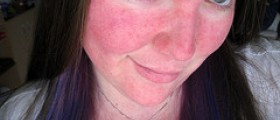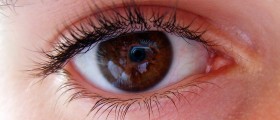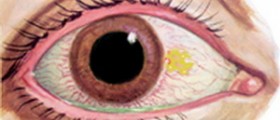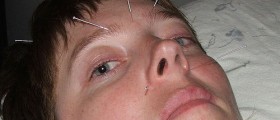
Ocular rosacea is an inflammatory disease and a manifestation of general rosacea. In contrast to rosacea, which is characterized by facial redness, ocular rosacea affects the eyes and the eyelids. Rosacea is a chronic inflammatory condition that normally affects the facial skin, nose and forehead. Ocular rosacea is often diagnosed with patients with general skin rosacea. In rare cases, ocular rosacea develops on its own without association to any other known skin problem. This inflammatory condition usually affects adults between the age of 30 and 60, and it is more frequent in women than in men. However, it is considered that the disease almost equally affects both sexes, but women are more likely to seek medical attention, because of the aesthetically unappealing character of rosacea. People with fair skin and light hair and eye color, prone to flushing or blushing, are at higher risk of developing rosacea.
Causes of ocular rosacea
The exact cause of ocular rosacea is still unknown. Sometimes the disease runs in the family but for most patients, there is no evidence of genetic association or linkage. Scientists believe that a delicate combination of hereditary and environmental factors causes ocular rosacea, as well as skin rosacea. However, certain factors may worsen rosacea in most patients. These factors include exposure to heat, vigorous exercise, exposure to sunlight, exposure to wind, exposure to very cold temperatures, hot or spicy foods and drinks, alcoholic beverages, menopause, emotional stress, and taking drugs that dilate blood vessels or taking corticosteroids.
Symptoms of ocular rosacea
Symptoms of ocular rosacea in most of the cases develop together with symptoms of skin rosacea. However, the symptoms may occur before or after the skin rosacea, or completely on their own. Most commonly the symptoms include dry and/or itchy eyes, burning sensation in the eyes, sensation of a foreign object in the eyes, blurred vision, hypersensitivity to light, redness, dilated small blood vessels in the eye, red and swollen eyelids and styes.
Treatment for ocular rosacea
The treatment for ocular rosacea is aimed to manage the symptoms. There is no definite cure for this disease. The most common treatment includes oral antibiotics and careful eyelid hygiene. Patients are often advised to scrub the eyelids gently with diluted baby shampoo or an over-the-counter eyelid cleaner and applying a warm compress several times a day. In more severe cases, doctors may prescribe steroid eye drops to reduce skin inflammation. Artificial tears are also used against the dryness but they should be taken with care as some of them can even aggravate redness when discontinued after long-term use.

















Your thoughts on this
Loading...